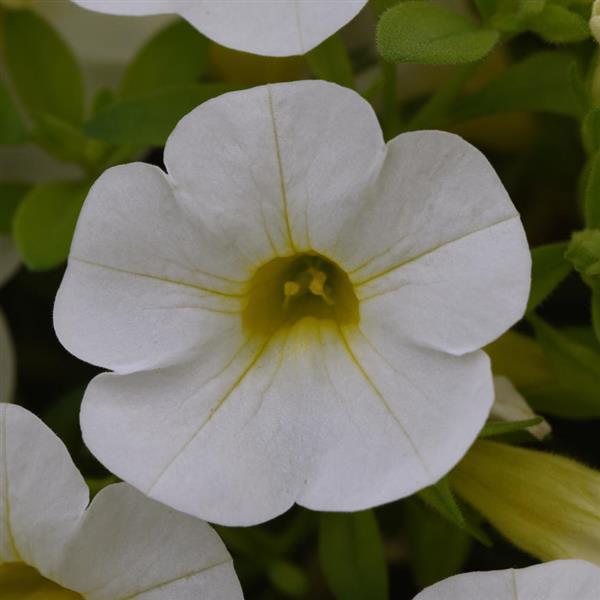Calibrachoa, Cabaret White
Price range: $7.99 through $8.99
Plant
Discount per quantity
| Quantity | 3 - 8 | 9 - 14 | 15+ |
|---|---|---|---|
| Price | Price range: $7.75 through $8.72 | Price range: $7.51 through $8.45 | Price range: $7.19 through $8.09 |
| % Discount | 3% | 6% | 10% |
Description
Calibrachoa ‘Cabaret White’: A Bright Blanket of Blossoms
Welcome to the World of Cabaret White
Have you ever wished for pure white petunias that never pause, never droop, and never ask for fuss? Calibrachoa ‘Cabaret White’ gives you that magic. These tiny, trumpet-shaped flowers glow like snowflakes, yet the plant itself stays lively even under summer heat. In other words, you get a whole hanging basket of light with almost no effort.
We’re going to explore every part of this charming performer. You’ll learn how it looks, why it thrives, and how you can keep it shining from early spring right through fall. Let’s dig in—together.
The Plant in a Nutshell
Pure-White Petals
Each bloom measures about one inch across. The petals overlap, forming a tight, five-lobed circle. A sunny yellow throat sits in the center, acting like a beacon for pollinators. Because the petals hold no extra markings, the white feels cleaner and brighter. This makes every blossom pop against green leaves and darker plants around it.
Trailing, Yet Tidy
Cabaret White trails, but it does not sprawl wildly. Stems grow 10–12 inches long, then arch down or outward. The habit is mounded at first, later turning waterfall-like. That balanced shape fills baskets, window boxes, railing planters, and even mixed beds without swallowing neighbors.
Fast and Fearless Bloomer
The Cabaret series starts flowering earlier than many calibrachoas. You can see buds when night temperatures still hover around 50 °F. Once open, blossoms cover the entire plant. After more than four months, they still refuse to quit. No deadheading needed—spent blooms drop on their own, clearing the stage for fresh ones.
Leaf and Stem Details
Leaves are small, oval, and slightly sticky. They remain a medium green even in strong sun. Stems are slender yet firm enough to handle wind. This combo keeps baskets looking neat instead of ragged.
Why We Love Cabaret White
- Color Versatility – White pairs with every hue. Slip Cabaret White beside red, pink, or purple flowers to make mixed colors glow. Put it next to silver foliage or deep burgundy coleus for dramatic contrast.
- Sun-Hardy – Many white flowers scorch; Cabaret White resists browning under blazing rays.
- Low Maintenance – No pinching, no tedious grooming. You water, you feed a bit, and you enjoy.
- Pollinator Friendly – Tiny throats welcome small bees and hoverflies. While the show looks delicate, it helps your garden’s micro-ecosystem stay strong.
- Season-Long Impact – From cool spring mornings to late autumn afternoons, the color stays fresh. Instead of swapping tired annuals mid-summer, you keep the same basket thriving.
Caring for Cabaret White
Light: Bright but Balanced
Cabaret White loves at least six hours of sun. Morning sun with dappled afternoon shade works in hotter climates. If you garden in cool coastal areas, full sun all day is perfect. Inside a greenhouse or sunroom, be sure to provide strong light so stems stay compact.
Temperature Sweet Spot
This variety handles heat up to the mid-90s °F without pause. Night temperatures down to 50 °F encourage even bushier growth. Frost, however, will end the show. Plant outdoors only after danger of freeze has passed in spring.
Soil and Potting Mix
Use a loose, well-drained mix. In hanging baskets, peat-based mixes blended with perlite or coconut coir keep roots both moist and aerated. The ideal pH falls between 5.5 and 6.2—slightly acidic—helping the plant absorb iron and keep leaves from yellowing.
Watering Wisdom
Calibrachoas dislike waterlogged roots. Water deeply, then let the top inch of mix dry before the next drink. During July heat, you may water daily in baskets, but always check moisture first. Instead of drenching late evening, water early morning so foliage dries fast, reducing fungus risk.
Feeding for Endless Blooms
Bloom power demands energy. Feed every one to two weeks with a balanced water-soluble fertilizer (such as 15-15-15) or use a slow-release granular feed at planting time. If leaves start paling even with feeding, supplement with an iron chelate spray. In other words, a little nutrition keeps the engine humming.
Pruning and Pinching
Cabaret White rarely needs shaping. If stems stretch beyond the look you want, snip them back by one-third. Within a week, new shoots appear, loaded with buds. This quick haircut also revives older baskets late in the season.
Troubleshooting Common Issues
| Symptom | Likely Cause | Quick Fix |
|---|---|---|
| Yellow leaves with green veins | Iron deficiency due to high pH | Drench soil with iron chelate, lower pH slightly |
| Wilting even when soil is wet | Root rot from poor drainage | Repot in fresh, airy mix and cut back on water |
| Sparse blooms in midsummer | Low nutrients | Increase feeding frequency, especially phosphorus |
| Sticky leaves covered in specks | Aphids or whiteflies | Hose off pests, apply insecticidal soap |
Remember, healthy plants fight pests naturally. So keep light, water, and nutrients in balance first.
Overwintering Options
In zones 9–11, Cabaret White can behave like a tender perennial. Trim back by half in late fall, move containers under a patio roof, and lighten water. Where winters freeze, take cuttings six weeks before frost. Root them indoors under grow lights. After more than one winter, you’ll have a steady supply of starter plants each spring.
Propagation Notes
Most Cabaret varieties are protected by plant patents. That means you can take cuttings for personal, non-commercial use but may not sell propagated plants. If you simply want extra baskets for yourself and friends, use four-inch cuttings, dip in rooting hormone, and tuck into moist, sterile mix. In two weeks, roots form. Keep humidity high but leave some air flow so stems do not rot.
Landscape and Design Ideas
Hanging Baskets
Pair Cabaret White with trailing blue lobelia and bright lemon sweet potato vine. The white acts as a clean backdrop while colored companions dance in front.
Window Boxes
Mix with coral diascia and lavender heliotrope. The window box gains fragrance, color depth, and balance.
Garden Beds
Plant in the front row of borders. Under taller salvias or ornamental grasses, the white waves reflect sunlight back up into the leaves above, making the whole bed shine.
Patio Bowls
Try a monochrome bowl: Cabaret White, silver dusty miller, and ivory verbena. The subtle shades echo modern outdoor décor.
Eco-Friendly Tips
- Choose Organic Fertilizers – Fish emulsion or seaweed feeds reduce chemical runoff.
- Collect Drainage Water – Place saucers under pots and reuse runoff on other annuals when possible.
- Invite Beneficial Insects – Surround baskets with herbs like dill or fennel that host lacewings. They keep aphids in check.
- Compost Spent Plants – At season’s end, chop and add stems to compost. They break down quickly and return nutrients to soil.
Instead of seeing Cabaret White as a disposable annual, think of it as part of a living cycle. You enjoy its color, then give its remains back to the earth.
Frequently Asked Questions
Does Cabaret White Need Deadheading?
No. Spent blooms drop naturally. You can pinch occasionally to refresh shape, but petals will not cling and spoil the look.
How Big Does a Single Plant Get?
Expect a mound 8 inches high and 18 inches wide. In baskets, stems may trail 12 inches beyond the rim.
Can I Grow It From Seed?
Calibrachoa seeds exist but are tiny and tricky. Cabaret cultivars are vegetatively propagated for uniform traits. Buying starter plugs or rooted cuttings is easier.
Is It Deer Resistant?
Deer usually ignore calibrachoa due to its slightly sticky foliage. In heavy deer zones, monitor early. If browsing happens, use netting or scent deterrents.
Will It Grow Indoors Year-Round?
Yes, under bright LED grow lights for 14–16 hours daily. Keep temperatures near 70 °F. The compact habit stays neat on sunny shelves.
Simple Month-by-Month Care Calendar
| Month | Task |
|---|---|
| March | Start indoor cuttings or buy plugs. Feed lightly. |
| April | Harden off outdoors on warm days. Check pH of potting mix. |
| May | Plant outside after last frost. Water deeply. |
| June | Begin biweekly feeding. Watch for aphids. |
| July | Trim back if stems exceed length. Increase water. |
| August | Refresh fertilizer. Remove any sun-scorched leaves. |
| September | Take new cuttings for wintering. Reduce feeding. |
| October | Move baskets under cover in cool zones. |
| November–February | Indoor plants: provide grow lights, minimal water. Outdoor annuals: add stems to compost. |
Cultivar Snapshot
- Botanical Name: Calibrachoa ‘Cabaret White’
- Series Origin: Selecta One breeding, part of the Cabaret line known for early flowering and uniform spread
- Habit: Mounded-to-trailing, 8–12 inches tall, 16–20 inches wide
- Bloom Color: Pure white with pale yellow throat
- Bloom Size: About 1 inch
- Light Needs: Full sun to light shade (6–10 hours)
- Water Needs: Moderate; allow top inch of soil to dry between waterings
- USDA Zones: Grown as annual in zones 2–8; tender perennial in 9–11
- Special Features: Self-cleaning, heat tolerant, pollinator friendly, no deadheading required
Bringing It All Together
Cabaret White is more than another trailing annual. It is a reliable partner that gives your garden a calm, bright anchor. We pour our time into soil prep, watering, and feeding, and the plant pays us back with months of crisp color. Instead of wrestling with fussy blooms, we relax and enjoy a living cascade of light. That is the beauty of this cultivar—you give a little care, and it returns endless charm.
Radiant Petals, Lasting Joy
Additional information
| Weight | N/A |
|---|---|
| Options | Starter Plug – 3 count, 4 in. (16.9 fl. oz.) Pot |





